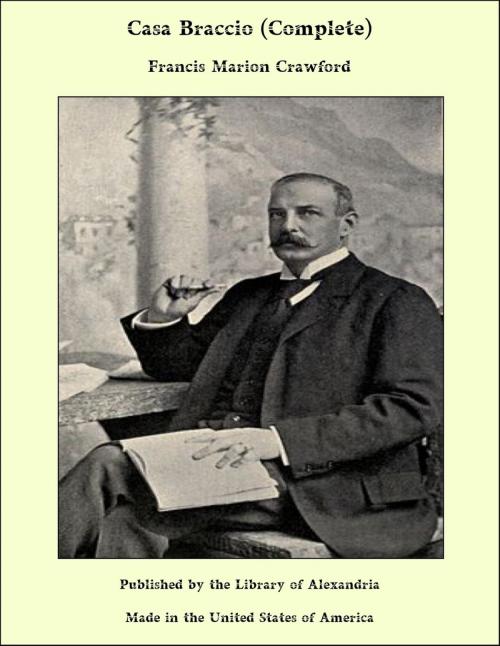| Author: | Francis Marion Crawford | ISBN: | 9781465604156 |
| Publisher: | Library of Alexandria | Publication: | March 8, 2015 |
| Imprint: | Language: | English |
| Author: | Francis Marion Crawford |
| ISBN: | 9781465604156 |
| Publisher: | Library of Alexandria |
| Publication: | March 8, 2015 |
| Imprint: | |
| Language: | English |
Subiaco lies beyond Tivoli, southeast from Rome, at the upper end of a wild gorge in the Samnite mountains. It is an archbishopric, and gives a title to a cardinal, which alone would make it a town of importance. It shares with Monte Cassino the honour of having been chosen by Saint Benedict and Saint Scholastica, his sister, as the site of a monastery and a convent; and in a cell in the rock a portrait of the holy man is still well preserved, which is believed, not without reason, to have been painted from life, although Saint Benedict died early in the fifth century. The town itself rises abruptly to a great height upon a mass of rock, almost conical in shape, crowned by the cardinal's palace, and surrounded on three sides by rugged mountains. On the third, it looks down the rapidly widening valley in the direction of Vicovaro, near which the Licenza runs into the Anio, in the neighbourhood of Horace's farm. It is a very ancient town, and in its general appearance it does not differ very much from many similar ones amongst the Italian mountains; but its position is exceptionally good, and its importance has been stamped upon it by the hands of those who have thought it worth holding since the days of ancient Rome. Of late it has, of course, acquired a certain modernness of aspect; it has planted acacia trees in its little piazza, and it has a gorgeously arrayed municipal band. But from a little distance one neither hears the band nor sees the trees, the grim mediæval fortifications frown upon the valley, and the time-stained dwellings, great and small, rise in rugged irregularity against the lighter brown of the rocky background and the green of scattered olive groves and chestnuts. Those features, at least, have not changed, and show no disposition to change during generations to come. In the year 1844, modern civilization had not yet set in, and Subiaco was, within, what it still appears to be from without, a somewhat gloomy stronghold of the Middle Ages, rearing its battlements and towers in a shadowy gorge, above a mountain torrent, inhabited by primitive and passionate people, dominated by ecclesiastical institutions, and, though distinctly Roman, a couple of hundred years behind Rome itself in all matters ethic and æsthetic. It was still the scene of the Santacroce murder, which really decided Beatrice Cenci's fate; it was still the gathering place of highwaymen and outlaws, whose activity found an admirable field through all the region of hill and plain between the Samnite range and the sea, while the almost inaccessible fortresses of the higher mountains, towards Trevi and the Serra di Sant' Antonio, offered a safe refuge from the halfhearted pursuit of Pope Gregory's lazy soldiers.
Subiaco lies beyond Tivoli, southeast from Rome, at the upper end of a wild gorge in the Samnite mountains. It is an archbishopric, and gives a title to a cardinal, which alone would make it a town of importance. It shares with Monte Cassino the honour of having been chosen by Saint Benedict and Saint Scholastica, his sister, as the site of a monastery and a convent; and in a cell in the rock a portrait of the holy man is still well preserved, which is believed, not without reason, to have been painted from life, although Saint Benedict died early in the fifth century. The town itself rises abruptly to a great height upon a mass of rock, almost conical in shape, crowned by the cardinal's palace, and surrounded on three sides by rugged mountains. On the third, it looks down the rapidly widening valley in the direction of Vicovaro, near which the Licenza runs into the Anio, in the neighbourhood of Horace's farm. It is a very ancient town, and in its general appearance it does not differ very much from many similar ones amongst the Italian mountains; but its position is exceptionally good, and its importance has been stamped upon it by the hands of those who have thought it worth holding since the days of ancient Rome. Of late it has, of course, acquired a certain modernness of aspect; it has planted acacia trees in its little piazza, and it has a gorgeously arrayed municipal band. But from a little distance one neither hears the band nor sees the trees, the grim mediæval fortifications frown upon the valley, and the time-stained dwellings, great and small, rise in rugged irregularity against the lighter brown of the rocky background and the green of scattered olive groves and chestnuts. Those features, at least, have not changed, and show no disposition to change during generations to come. In the year 1844, modern civilization had not yet set in, and Subiaco was, within, what it still appears to be from without, a somewhat gloomy stronghold of the Middle Ages, rearing its battlements and towers in a shadowy gorge, above a mountain torrent, inhabited by primitive and passionate people, dominated by ecclesiastical institutions, and, though distinctly Roman, a couple of hundred years behind Rome itself in all matters ethic and æsthetic. It was still the scene of the Santacroce murder, which really decided Beatrice Cenci's fate; it was still the gathering place of highwaymen and outlaws, whose activity found an admirable field through all the region of hill and plain between the Samnite range and the sea, while the almost inaccessible fortresses of the higher mountains, towards Trevi and the Serra di Sant' Antonio, offered a safe refuge from the halfhearted pursuit of Pope Gregory's lazy soldiers.















